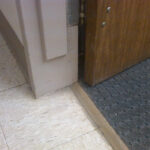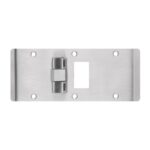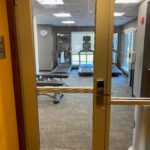I’m writing this blog post from 33,000 feet and the person in the seat in front of me is in my lap so it may be a short one. Feel free to add your 2 cents’ worth in the Comments section below, and we can make this a collaborative piece. Maybe you know of articles about other school fires that we can link to, or code changes that were made because of a tragic event. I’d like to illustrate why the current pattern of legislation outside of the established and effective code development process could take us down a dangerous path, by addressing security without adequately considering life safety.
As I mentioned in my recent post called Barricade Device? Think Twice!, fires do occur in schools even though school fire fatalities are no longer common. While some point to this as evidence that fire code requirements in schools are less important than security concerns, others cite the strength of current codes and enforcement as the reason for the reduction in serious school fires.
Today is the 61st anniversary of a fire at the Cleveland Hill School in Cheektowaga, New York, where 15 students (age 10-12) were killed. There are PDF articles about this school fire and several others on NFPA’s list of school fires with 10 or more fatalities.
An article in today’s edition of The Buffalo News discusses the effects that this fire had on fire safety:
There are also less obvious – but monumentally important – outcomes from the fire.
Take a close look around the next time you’re in a school building. Notice the fire alarms, extinguishers, rescue windows and frequent drills? They can all be traced back to that fateful day, experts say.
“All of that put together has made our school buildings so safe when it comes to fires,” said David G. Hess, Cleveland Hill’s director of facilities. “That fire has really made a difference.”
The fire touched virtually every aspect of fire safety in schools with new laws and regulations on the placement of windows, halls and doors, and control of heating plants.
Today, Cleveland Hill takes fire safety as seriously as can be.
“I get no pushback or trouble from people who might otherwise give me a hard time about a coffee pot in their classroom or a ceramic heater under their desk,” Hess said.
“They don’t do it because they know what could happen. They’ve seen what disaster can come about from a situation like that.”
Another article in The Buffalo News describes a new exhibit about the tragedy, which “aims to inform, heal, inspire.” This article illustrates just how little time the students and teachers had to escape the blaze, with the only door blocked by fire:
Late that Wednesday morning in 1954, more than two dozen sixth-grade students were in Melba Seibold’s music class, in a wooden annex of the school, when everybody in the room heard an explosion.
“Immediately your first response was to run to the doorway to see what was going on,” one survivor says in a student-produced documentary titled “Through the Silence,” which is featured in the exhibit. “Almost immediately the doorway was completely engulfed in flame and the smoke was coming into the room.”
Cervi also tells interviewers the flames spread quickly.
“There wasn’t like five, 10 minutes,” he says. “It was 30 seconds to a minute and the smoke and the heat was horrendous. It was just immediate flame. You couldn’t get to the doors. Go to the windows, you couldn’t open them. A couple people broke some things and climbed out. If you didn’t get out within a minute, you didn’t make it.”
Current codes are based on lessons learned in past events, illustrating that we can not afford to sacrifice life safety in favor of less expensive security. Whether you agree or disagree, join the conversation by leaving a comment below.
For more information about school safety and security, click the “Schools” tab at the top of this page.
You need to login or register to bookmark/favorite this content.






It is unfortunate that safety is improved at the cost of someone’s life. I guess in some circumstances a problem is not seen until something had happens.
What is bad though, lessons have been learned by loss of life in the past, but humans continue to repeat bad choices and people die.
We are quite fortunate to have people who dedicate their lives and careers to fire safety in all occupancies. The codes provide “school of hard knocks” lessens gleaned from the past. What has happened can happen, the old saying goes. There were some hard lessons. By way of example. It helps to understand that fires are no stranger to schools although so much has been done by way of fire exit drills and improvements of buildings based on the evolving understanding taught by experience. I don’t expect you to post all this Lori unless you want to.
1. Hobart School Fire (Babb Switch) Oklahoma. It was Christmas eve and most of the kids and parents were gathered in the light frame construction rural schoolhouse, There were between 200 and 250 people, far over occupant load in the 25 by 36 foot building when the fire broke out, just as Santa Claus had started handing out gifts. Many fire safety deficiencies were present. The structure had only one door, and it opened inward “like a people check valve” one person observed. In this era, they used gas lamps and the already swift progress of the fire was further accelerated by these blowing up. Open candles were in use on the tinder dry Christmas tree and one of them fell over, starting the blaze. There was no provision for dealing with any size fire and no readily available water. As with anything of this nature, it was a nightmare to those who witnessed the deaths of 32 men, women and children. More than half the dead were children. The awful story is detailed in “Fire in America”, a book by Paul Robert Lyons. The State Fire Marshal had condemned building features like the inward opening door but all he could do was point the hazard out, at that time he had no basis for action because he was not backed up by any code. Even with modern codes, folks can create equivalent hazards. I was in a school a few years ago and found the door to the library could not be opened. Since there was another door, I went around to it and found the entire library was full of pasteboard boxes. The teachers had constructed a labyrinth out of cardboard for a Halloween area for the kids complete with lights, cords, etc. Within an hour it was all outside.
2. The London,Texas School Disaster. This was a fairly substantial building that used 72 heating units that had a small gas burner at the base under a small water chamber. To provide the gas, there was significant pipe distribution system under the crawl space beneath the floor which trapped a volume of about 46,000 cubic feet. There was a gas explosion that originated in this space that blew the floor upward and destroyed all piping so the source of the gas explosion was not determined. In an instant 294 school children and teachers were dead. An explosion such as this can even wreck most of the fire doors, sprinklers, etc. of a modern building.
3. There were others, the 1954 Cheektowaga, New York school fire that claimed 15 children housed in a temporary barracks type classroom which used highly combustible ceiling board.
4. One of the more famous fires, the Our Lady of Angels School fire in Chicago in 1958 that claimed 95 children and teaching sisters. It started in the basement and spread up the open stair to the second floor. Many of the windows were effectively blocked by substantial screens that prevented escape, something that was not planned in their use. This fire resulted in a number of actions including the more frequent use of fire sprinklers, redesign of stair by enclosing them where prudent, and a more robust future response by the Fire Department. There had been so many false alarms that only a ladder truck, pumper and battalion chief responded initially. A normal assignment would have been 4 pumpers, 2 ladder trucks and multiple fire officers and men. The “school of hard knocks is a good teacher.”